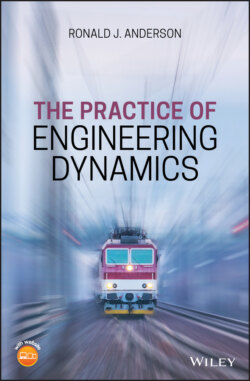Читать книгу The Practice of Engineering Dynamics - Ronald J. Anderson - Страница 16
1.3 Two Dimensional Motion with Constant Length
ОглавлениеFigure 1.3 shows a rigid rod of length, , rotating about a fixed point, , in a plane. An expression for the velocity of the free end of the rod, , relative to point is desired.
Figure 1.3 A rigid rod rotating about a fixed point.
By definition, the velocity of relative to is the time derivative of the position of relative to . This position vector is designated and is shown in the figure.
In order to differentiate the position vector, we must have an expression for it and this means we must first choose a coordinate system3 in which to work. For a start, we can choose a right handed coordinate system fixed in the ground. The set of unit vectors is such a system. The angular velocity of this coordinate system is zero (i.e. ) since it is fixed in the ground.
An expression for the position of relative to in this system is,
(1.7)
We apply Equation 1.6 to to get,
(1.8)
In this coordinate system, it is clear that there is a rate of change of magnitude of the vector only and the velocity of point relative to after performing the simple differentiation is,
(1.9)
Another derivation of the velocity of relative to might use the system of unit vectors that are fixed in the rod. The advantage of using this system is that the position vector is easily expressed as,
(1.10)
Note that the length of this vector is a constant so that the total derivative must come from its rate of change of direction. The angular velocity of the coordinate system is equal to the angular velocity of the rod since the coordinate system is fixed in the rod. That is,
(1.11)
and the velocity of relative to is therefore4,
(1.12)
Since is constant, , and the final result is,
(1.13)
We now have two expressions for (Equations 1.9 and 1.13). Since there can only be one value of this relative velocity, the two expressions must be equal to each other. However, the use of two different coordinate systems makes them look different. In order to compare them, we must be able to transform results from one coordinate system to the other.
Keep in mind that sequential sets of unit vectors are related to each other by simple plane rotations. Also note that the unit vectors are not related to any point in the system – they simply express directions. Given these two facts, we can relate the two sets of unit vectors we have been using by noting that (i.e. the plane rotation relating the two sets is a rotation about the or axis). The relationships between the two sets of unit vectors can be expressed as follows.
(1.14)
or
(1.15)
The first transformation (Equation 1.14) can be used with Equation 1.13 to show that,
(1.16)
This is the same result as that shown in Equation 1.9.
Similarly, the second transformation (Equation 1.15) can be used with Equation 1.9 to show that,
(1.17)
Expanding this yields,
(1.18)
This is the same result as that shown in Equation 1.13.
The transformations described in this example are typical of those used in dynamic analysis. Dynamicists are prone to using whatever coordinate system is appropriate at the time and, sometimes, there are many intermediate coordinate systems used in deriving the final system. Nevertheless, each coordinate system in the sequence must be right handed and must be generated by a simple plane rotation from the preceding system.
